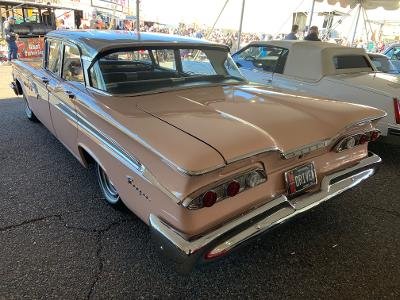Our featured automobile is a very nice looking 1959 Edsel Ranger Four Door Sedan. The Edsel was produced by Ford Motor Company from 1958 to 1960. Ford made the Edsel it’s own division within the company although the models were produced at Mercury plants.

The 1960 Edsels, because of extremely weak sales, were taken out of production near the end of 1959 therefore the last model year (1960) of the three was greatly shortened and these are the rarest models.
Why the Edsel?
Ford invested a lot of money with a almost year long teaser campaign prior to the Edsel launch. Ford expected good things from this new nameplate which was named after Henry Ford’s son and at one time Ford’s president.
Ford thought the Edsel brand would help them increase their market share against General Motors and Chrysler. Chevy had recently come out with the Impala in 1957 and, even though they had the popular Fairlane, Ford needed to play some catch up. In regards to GM, the Edsel was to be an upscale competitor to the Oldsmobile.
Roy A. Brown Jr was the Ford designer who created the Edsel. Ford wanted him to design an upscale looking automobile for car buyers with moderate budgets. Ford wanted Brown to come up with an automobile that looked different than anything before it.
The Edsel Launch
After an expensive pre launch marketing campaign Ford Motor Company introduced the 1958 Edsel in early September 1957.
The models chosen for the Edsel would be the Citation, Corsair, Pacer and Ranger. The four lines came with a combined total of eighteen models which included station wagons.
As a fairly big surprise to Ford, the car buying public found the Edsel to be unattractive as well as over priced. Ford ended up losing about a quarter of a million dollars on Edsel’s development, production and marketing efforts. As mentioned, Ford decided to pull the plug on the Edsel nameplate in late 1959. When the 1960 Edsel was introduced it shared many body panels and interior trim with Ford. To tell the 1960 Edsel from other Ford models you would see this difference basically in the grille and tail lights.
The 1959 Edsel Ranger
The Edsel Ranger was the nameplates entry level model. Styling and components for the 1959 Edsel were greatly affected by the terrible sales numbers from 1958. The new Teletouch Drive transmission that was planned as a 1959 option was scrapped. Tail lights were taken from the Continental and the chassis was the Unique design elements were cut, and the Edsel began to lose some features that made it an Edsel. The reason for all of this was to save as much money as possible in what Ford realized was a losing proposition.
As mentioned, the Ford Motor Company had big expectations for their new Edsel nameplate and expected that this model would push up their market share.
All of this changed of course when Edsel sold 63,000 units for the 1958 introductory year. The 1958 model year was also when some 18 different Edsel models were offered and because of prior plans the same number of different models were produced for 1959. The results were even worse for 1959 with some 44,800 units produced. The 1959 sales performance sealed the fate for the Edsel with only 2,840 Edsels made for the 1960 model year. The two Edsel models produced for 1960 were the Ranger and the Villager.
While some may refer to the Edsel as the Titanic of automobiles, that might be an overstatement. Sales of course was a disaster but mechanics and automobile quality is a different thing altogether. Most likely because the sales numbers were incredibly low, some transfer that negativity to the automobile’s mechanical integrity which is a mistake in our opinion.
1959 Edsel Ranger Specifications
Several engines were available for the 1959 Edsel Ranger line. These included a 223 cubic inch Inline Six, a 292 cubic inch Y-Block V-8 and a 361 cubic inch V-8. Plenty of power choices with the 59 Edsel Ranger.
Transmissions included a three speed manual a two speed automatic, and a three speed automatic.
Dimensions include a 120.inch wheelbase, overall length 210.9 inches, 79.8 inch width. 56.0 inch height.
Total 1959 Edsel Production was 44,800 vehicles. 1959 Edsel Ranger production was 30,200 vehicles. Edsel Ranger Four Door Sedans like the example shown in the article accounted for 12,800 units. An interesting note is that the 1959 Edsel Four Door Sedan was the number one model produced.
Related Auto Museum Online articles are on the links below..
Reference material for this article includes..Disaster in Dearborn : The Story of the Edsel by Thomas E. Bonsall…Popular Mechanics Monthly Magazine-September 1957…Complete Book of Collectible Cars by the Editors of Consumer Guide.
The Edsel as a Collector Car
There is no mistaking an Edsel for another car. The all are unique looking and that;s a part of their collector interest. There are many collectors who place great value on restored Edsel automobiles from any of the three model years the nameplate existed. Generally the Edsel Convertibles are the most desired model and certain examples have sold for well over $100,000. The rarest of theme all is the 1960 Edsel Ranger Convertible since a mere 76 of these models were built before production ceased in November 1959.
There have been Edsel Convertibles from any of the three year run receiving very strong bids. While the Edsel had extremely weak sales numbers in the late 1950’s, they can make excellent collector cars today.
Restored Edsel Convertibles in general are the highest priced collector models. The 1959 Edsel Four Door Sedan example like the one featured here and in excellent restored condition has been sold generally in a price range from $20,000 to $29,000. There are certainly sales lower than this range but mileage, overall condition, originality and degree of restoration if any are determining factors.
(Article and photos copyright Auto Museum Online)

